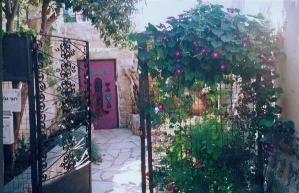
Safed Artists' Quarter
 Safed Artists' Quarter |
Up in the green mountains north of the Sea of Galilee is the holy town of Tzfat (Safed in English), an historic mountain top town famous as a centre, perhaps the centre, of Jewish mysticism. Safed is in my opinion one of the most interesting towns in Israel located in one of the most beautiful parts of the country.
The town is divided between the old areas close to the town centre and various modern suburbs further down the slope of the mountain or on nearby ridges. At the top of the mountain are the ruins of the old citadel, a fortress dating back to Roman times, and used by various other rulers throughout the centuries. From this high point, the town tumbles down the mountain side in a mixture of old and modern buildings and narrow winding streets and alleys. The old city and the nearby artists' colony are a maze of narrow cobbled streets, old stone houses and synagogues and lots and lots of stairs. The centre of town and the suburbs are more modern, and are built in typical urban Israeli style exemplified by utilitarian concrete apartment buildings, though there are also many lovely houses and more modern buildings which are far more pleasing to the eye. One of the nicest modern developments is the new Breslev Quarter on the edge of the Old Town.
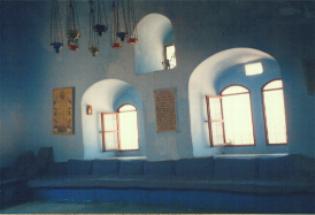 Rabbi Yosef Caro Synagogue |
The old town is famous for its many historic synagogues and religious academies. Many of the synagogues are beautiful, with intricate wood carvings, decorative brass and coloured glass lamps, painted inscriptions on the walls in calligraphy or brightly painted window frames and pillars. Many of the buildings are painted blue, which in many parts of the Middle East, in both Jewish and Muslim tradition is considered a lucky colour.
At the edge of the Old City, overlooking the mountains, is the Beit HaMeiri Museum of local history. The museum has everyday items, photos, legends, historic documents and displays on everday life in Tzfat in earlier centuries, focusing on the late 19th and early 20th centuries.
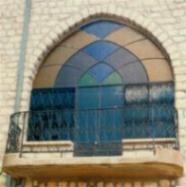 Beit HaMeiri Museum |
There are various shops in and around the market in the Old City selling all kinds of religious and decorative items made from glass, silver, brass, wood and ceramics. While Tzfat is no longer famous for its wool industry as it was in Ottoman times, the town still produces a selection of textiles, including tallitot (prayer shawls worn by Jewish men) and silk screen, embroidered and applique wall hangings and religious items. Tzfat is also famous for the production of unusual decorative coloured candles in a stunning variety of colours many of which are also braided to form all kinds of geometric shapes.
Adjoining the Old City is the artists' quarter home to many different kinds of galleries, from the big grand galleries of successful and well known painters, to small hole in the wall' studios of young artists who are just starting out, or who have never become famous. In many of the galleries you can actually see the artists at work.
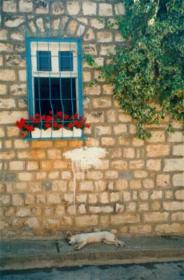 Siesta in the artists quarter |
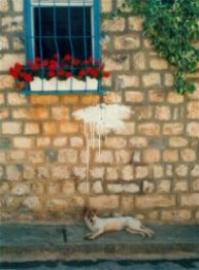 See he really was just resting... |
One of my favourites is Michael Leaf's gallery. Leaf specialises in humourous and satirical paper maché sculptures, featuring various aspects of Israeli life, such as Tel Aviv traffic jams, Israelis' obsession with mobile phones and one showing the Israeli method for getting on a bus - everyone swarms around the door, grabs onto any available part of the bus and pushes everyone else out of the way to ensure that they will be first on the bus... Another favourite gallery is Kaszemacher's gallery on the edge of the market.
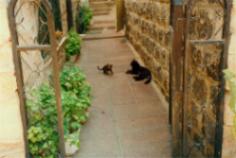 Like every Israeli town, Tzfat has cats |
Though an important historic and religious centre, Tzfat is not simply a romantic tourist site but also modern town with regular shops, businesses, schools and a hospital, as well as its share of the problems common in small provincial Israeli towns.
Tzfat is a majority secular town, but it is still quite traditional in many respects and remains a centre for Jewish learning. Most businesses close in honour of Shabbat (the Sabbath), from sunset on Friday afternoon until the stars come out on Saturday night, and the town is quiet and peaceful over the Sabbath. I've noticed many foreign guidebooks which ridicule this quiet Shabbat atmosphere and advise visitors to avoid spending the weekend in Tzfat, but personally I always advise friends to do the opposite. I have spent many weekends in Tzfat and look forward to many more. Shabbat in the old town of Tzfat is very special. In some ways the town is very quiet, in others it is still as vibrant, just taking life at a slightly slower pace. There are dozens of synagogues to chose from, each with their
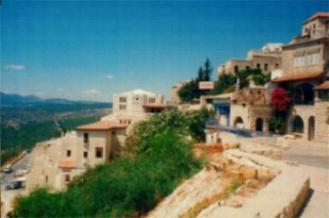 New Breslev neighbourhood near the Old Town |
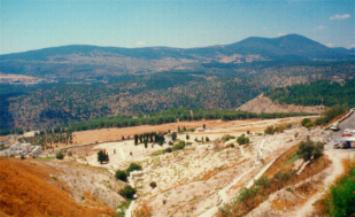 View of the outskirts of Tzfat towards the cemetery |
Tzfat is one of the highest places in Israel and in ancient times it was used for signal fires, a communication system used mostly for signalling that the new moon had been sighted, and used for setting the dates for the festivals, though the system was also used in times of crisis to signal a warning to other towns. Due to it's strategic mountain top location it was the scene of battles during the crusades, and during that period the town changed hands several times between the Christian Crusaders and the Muslim Arabs and later Mamluks, before the Ottoman Turks captured it in the early 16th century, ushering in a relatively more peaceful and prosperous era for the town.
The ancient cemetery in Tzfat contains the graves from the biblical and Talmudic periods, although many ancient graves were damaged over the centuries by earthquakes, especially the "big one" of 1837. The most famous ancient tomb is that of the prohpet Hoshea Ben Be-eri, though many famous Jewish scholars are also buried there, including Talmudic sages such as Nahum Ish Gamzu.
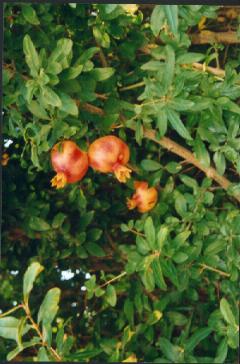 Pomegranates in Tzfat |
Over the centuries Tzfat has been home to many Jewish sages and rabbis and has been an important centre for Jewish learning, making it one of the holiest Jewish cities after Jerusalem and Hebron. Tzfat's golden age' was during the 16th and 17th centuries when the Ottoman Turks ruled the area and allowed the Jews to live in peace for the most part, and also allowed Jewish refugees from the Inquisition in Spain and Portugal to come and live in Tzfat.During this period of relative tranquillity many Jewish scholars and mystics lived in Tzfat, and many important religious books were written, both on Jewish mysticism, the Kabbalah, and on Jewish religious law, in particular the Shulhan Arukh, a key Jewish legal code written by Rabbi Yosef Caro, one of the leading scholars of his time.
Many religious poets also wrote in Tzfat, and many of their poems have become part of the Jewish prayer book. Most well known among them is probably Rabbi Shlomo Halevi Alkabetz, composer of 'Lekha Dodi' (Come my beloved), a beautiful hymn sung during the Friday night Shabbat inauguration service and one of the highlights of of the special Shabbat liturgy.
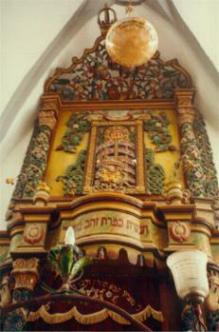 Ark in the Ari Synagogue |
The most famous scholar living in Tzfat during the 16th century was Rabbi Yitzhak Luria, the Ari hakadosh, one of the leading Jewish mystics who inspired Jews from all over the world and after whom two synagogues in Tzfat were named. Many Jews come to Tzfat especially to pay homage to the Ari and to immerse themselves in the chilly waters of the Ari's mikvah (ritual bathing pool) on the outskirts of Tzfat.
Much of the town's rich ancient history was wiped out in a big earthquake in 1837, in which 2000 people died and most of the town's buildings were destroyed, including many beautiful synagogues. There are many legends about how the righteous people of Tzfat managed to save some of the synagogues and their congregations. Tzfat was rebuilt afterwards, and the survivors did their best to reconstruct the town's architectural treasures from the ruins. The city was damaged again in the 19th century during the Druze (a sect which broke away from Islam in the 11th century whose members live in the mountains of northern Israel, Lebanon and Syria) rebellion against the Ottoman Turks and then again during the First World War in the fighting between the Turks and the British and during the 1948 Arab-Israeli war.
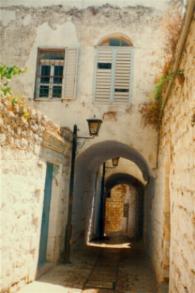 Alley in the Old Town |
Despite this, much of the old town has survived or have been restored. Since the 1970s in particular the Old City has been the focus of several restoration projects. Many are still underway thanks in part to the volunteers from the Livnot Ulehibanot (To Build and be Built) programme started 18 years ago which brings young Jews from around the world to Tzfat to develop their Jewish knowledge while at the same time donating their physical labour to renovating old buildings. Throughout old Tzfat you notice restored buildings bearing small round ceremic tiles with the Livnot logo, evidence of the good work done by their volunteers.
Copyright 2000 by Leiah Elbaum. Text and photographs on this page are by Leiah Elbaum. Last updated 2 July 2000.